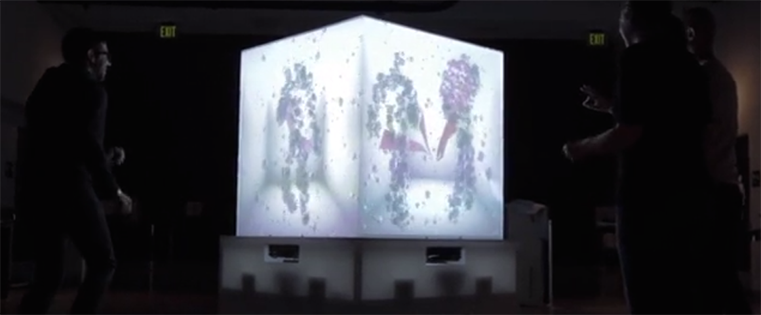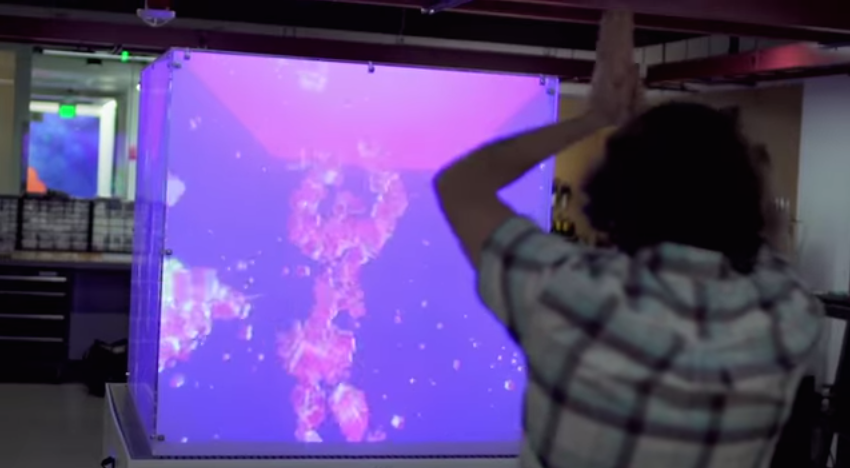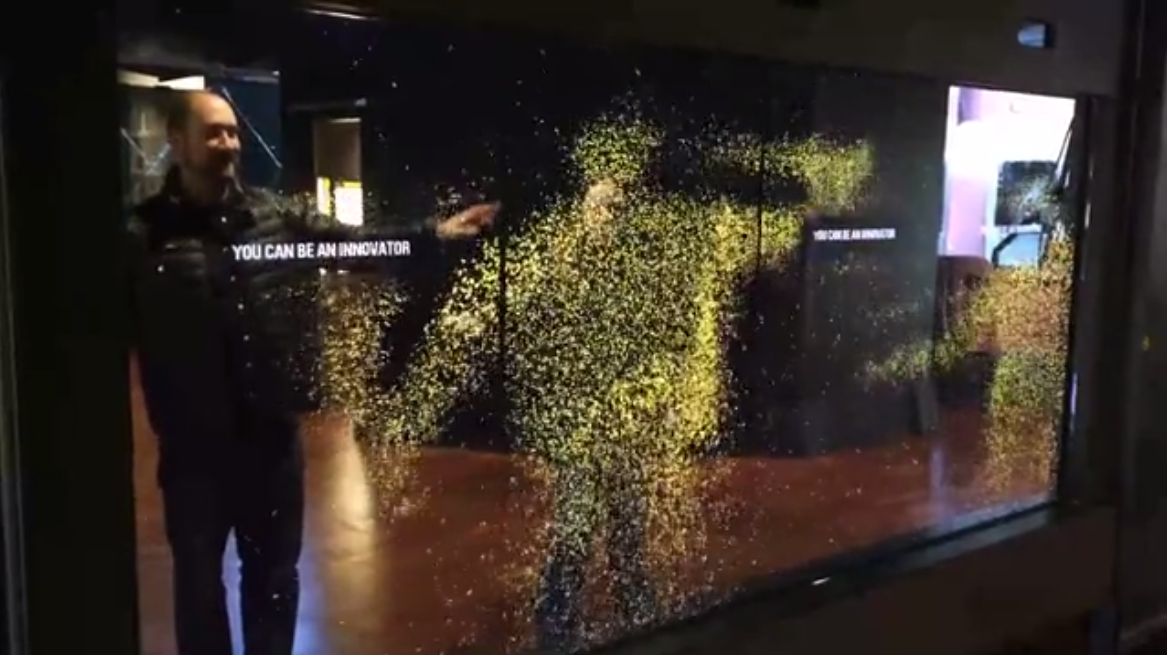
This post originally appeared on Agency Post. To read more content like this, subscribe to Agency Post.
Are our digital lives blocking our ability to experience physical things? Can technology make us less or more human?
Maybe these aren’t the right questions. Instead, perhaps we should be asking: How can we architect experiences where technology fosters connections?
That’s the challenge San Francisco-based Stimulant and its band of creative technologists have taken on. Darren David, who has a background in development, design, and project management, founded the San Fransico-based shop in 2008 while he was “running” from developing another Flash website. And he wanted to work for and lead a company that solved interesting problems. This was right after the introduction of the iPhone, and there were very few — if any — firms navigating how modern technology could be used from a brand perspective.
When David’s team first began doing digital installations for branded events, there was a barrier. People has been taught not to touch screens, so they were hesitant. But they were “touch curious,” as David said.
Fast-forward a few years. Now, most people, and even young children, will touch anything with a flat surface that they think might react. The advancements in technology coupled with brand and consumer desire for interesting digital experiences has propelled Stimulant to the forefront of the creative technology field, creating what they call “smart spaces.”
The Intersection of Design, Art, and Marketing
Stimulant had worked with Microsoft on the first version of what is now Surface during its founding year. A few years later, that relationship culminated in the Cube, a four-foot-by-four-foot interactive art installation that appeared at the Decibel Festival in 2014.
Sitting on top of a two-foot tall base, the Cube is a square structure made from projection material that houses five computers and four Kinect devices. These four Kinect devices are connected to one another so they can communicate.

It works like this: You stand on one side of the cube and your avatar appears on the screen. As you move, the avatar moves as well, with pixels and squares exploding across the screen. When another person approaches the other side of the Cube, both of your avatars connect through a digital ribbon. Suddenly, your movements to the music are connected with the other person’s, and the connection causes a collision of colors and animations.
“We really like using technology to get people to interact with each other so that the technology is not coming between them,” David said. “It’s actually facilitating them interacting.”
Stimulant has developed a 3D virtual life simulation, where conference attendees could create virtual bioluminescent life forms that interacted with creatures made by other attendees. It has launched a music sequencer for an interactive gaming platform, and it created a molecule pipeline explorer for a medical tradeshow.
The team uses technology to tell a story, to enhance an experience, and/or to give people a different perspective. But what makes their projects so interesting is that they do this through the intersection of physical and virtual worlds. It tests our knowledge of the boundary between the two; how one influences the other.
Stimulant’s staff members come from varied backgrounds: engineering, architecture, art, design, and development. But the concepts and execution of its projects are looked at through the lens of spatially literate design, a concept that defines their approach creating brand experiences.
What is Spatially Literate Design?
When you’re designing an online experience, you can count on a few factors. You know the dimensions. There are conventions used in design that people recognize. They know how to click on a button to get to the next page. They know where to look for a contact form. It’s also a place where the user is typically in control.
This is flipped on its head when a person enters a branded environment.
“When you’re online, everybody is the same height,” David said. With a physical experience, “You are now at the whim of the environment which you’ve entered. That has a huge impact on how we present information, how we let somebody know that something is interactive, how we reward their curiosity, and let them know that they’re being successful.”
 3D virtual life simulation at CES for Intel.
3D virtual life simulation at CES for Intel.
This is why spatially literate design and its concepts are so important for brands creating experiences. So, what does this tongue-twisting term actually mean?
At its core, it is similar to how we think about contextual marketing: Spacial literate design is delivering the right message in right solution in the right place at the right time for the right people. You have to understand not only the physical space but also why someone would interact with something in that physical space. What were they doing beforehand? What will they do afterwards? How does the design adapt to the environment it is in?
The place where we interact matters just as much as the designed interactions.
Why the Physical Still Matters
Brands are slashing their traditional budgets and choosing instead to invest in social platforms and innovations.
You can listen to your favorite music artists’ songs on Spotify, watch their videos on YouTube, and even follow them on Twitter. But that will never compare to the experience of seeing the person on stage or being a part of a swaying crowd or feeling the hum of vibrations. It’s in the latter situations when people let their guard down.
“Immersion takes place when the audience forgets that it’s an audience at all,” Frank Rose wrote in a recent article in Strategy+Business. “Immersion blurs the lines — between story and marketing, storyteller and audience, illusion and reality. That gives it enormous impact.”
Branded physical experiences are also interesting in that there is so much room for experimentation.
“People have very clear expectations as to what watching a commercial is like, what seeing a billboard is like or seeing an ad,” said Nathan Moody, Stimulant’s design director. “When you start integrating technology into branded experiences and physical places, it’s incredibly powerful because that is possibly the last frontier where consumer expectations are really not set in stone.”
The act of adding a technology element or attraction to a branded experience wakes people up. It causes them to look at something other than their smartphone. And if you can get the person’s attention, you’ve won the first battle. The next battle is securing their emotions.
How Experiences Influence Emotions
Tall ceilings make us more creative. Round objects make us feel safe. Our surroundings — objects, colors, textures, lighting, smell, and even the height of the room — influence our mood, behaviors, and attitudes.
And it’s our attitudes that holds the key to a brand’s survival and growth. The most difficult factor to change is the one connected to our emotions.
“Beliefs are those attributes we believe a brand possesses, attitudes are how we ourselves feel about the brand,” wrote Robert Heath in Seducing the Subconscious. “The distinction is very important, because although beliefs can influence attitudes, they cannot influence behavior; only attitudes are able to do that.”
Attitudes are why we buy what we buy. Beliefs like “whole wheat is healthier than white bread” are based on either fact or fiction — or a little bit of both.
Influencing attitudes is a much larger challenge; one that can’t be taken on from the confines of a web browser or with a 140-character message. But that doesn’t mean we need to go back in time. Technology can be used to change attitudes.
Brands can do this by bridging the divide between physical and the virtual world.
6 Lessons for Designing an Experience
We are now used to moving fast. Campaign launches are more iterative. In a fast-moving world, we tend to favor quick executions over meticulously planned projects. A brand experience that fuses the digital and physical world takes time, experimentation, and a vision.
1) Tell an immersive story.
The first lesson in designing an experience is to tell a story. But storytelling in the event world with a technology element requires two perspectives.
First, you have to consider the creator’s story. What feelings does the brand want to evoke in the viewer? What information does the viewer need? How does this piece of technology add value? How can the brand be the creator and supporter of the story without overpowering it?
The second concern is the user’s narrative. How do they travel through the space? What interests them, surprises them, delights them? What can they learn from this journey?
“It’s rare when those two story lines intertwine,” said Moody. “It’s like two guitar strings being plucked at the same time. They could be in perfect harmony, or they are very atonal.”
 Exhibit for MOHAI’s Bezos Center for Innovation
Exhibit for MOHAI’s Bezos Center for Innovation
This requires brands to think beyond what their story is. They have to figure out how they can interweave their story with the story of the viewer seamlessly.
2) Create an element of discovery.
Experiential events work well when there is an element of learning involved. This doesn’t mean you have to quiz your attendees. You should approach it as if you were a museum curator. Some people will meander throughout the galleries, taking in the overall experiences. Others will want to wear the headphones and learn as much as they can about a work or art. They want to study and interact.
The learning moments become the basis of stories; stories attendees tell to their friends and share on social media. “Part of the user narrative is building systems to let people feel like they’re discovering things on their own,” Moody said. “That’s where they remember brand impressions.”
Discovery leads to surprise, delight, and the desire to tell other people what you discovered.
3) Measure the results differently.
In the digital world, we worry about metrics. We consider visit-to-lead, lead-to-customer, customer-to-repeat-customer conversion rates. We care about Likes, retweets, comments, and time spent on a given web page. There are a million metrics we could measure.
When designing a brand experience, the metrics are a bit different. You can’t predict how long an experience will remain with someone. It’s difficult to know how deeply someone was affected. It’s hard to tie the emotions felt during an event to a purchase.
Stimulant thinks of measurement differently: They consider the ROI of the event for the viewers. “The biggest gift anyone can give you as an interaction designer is their attention,” Moody said. “How do you reward that? Delivering the highest return on attention possible [for viewers] influences almost every decision we make.”
When planning your next event, consider this approach. How can you gain an attendee’s attention and then reward them for their time? What can you do that will make it all worth it? What’s the ROI of the viewer?
4) Consider the context.
Designing the experience of an event requires you to think through a million different scenarios. There’s no perfect path to the event location. And even when someone arrives, there are other people that they share the space with. In addition, the emotional state of the person might influence their behavior and impression of the day.
With spatially literate design, these considerations come into play. When considering a project, such as the Microsoft Cube, Stimulant’s team considers things as small as the material of the floor. Is it comfortable? Can someone stand in an area for 10 or 15 or 30 minutes without being drawn out of the experience because of discomfort?
It’s not as easy as thinking about a one-to-one interaction. You need to consider, one-to-one, but also one-to-many, many-to-one, and many-to-many.
5) Respect the difference between private and public.
We act differently when we’re in a public setting. Some are more cautious; some like the spotlight; others simply like to watch what people do. Most people don’t like to fail in public.
When there is technology involved, designers have to be aware of the difference. And this certainly applies to events involving technology. “People don’t like to be on display so a lot of what we have to do with this physical experiences is earn trust from a distance right off the bat,” David said.
The technology has to invoke enough curiosity that people want to engage with it, but it needs to seem logical so that it earns the person’s respect.
6) Don’t make technology a barrier.
“People don’t pay to see technology,” David said. “They don’t go to a location because there’s technology. They go for the experience.”
Don’t plan an event around a piece of technology. It might get you some buzz, but that’s not the point of planning an event. If that’s all you are after, film a YouTube video. “If we do our jobs right, we don’t want people actually focusing on the technology at all,” David said.
People should feel the experience. An overwhelming focus on technology will only make them question it, and this will immediately pull the person out of the narrative you have constructed.
A Change in Attitude
Whether you choose digital, the physical, or a combination of the two, create an experience that makes people feel something: wonder, curiosity, happiness, surprise, delight, and so on. By evoking emotions, you’ll build connections and alter attitudes — and that’s a story worth telling over and over again.
![]()







